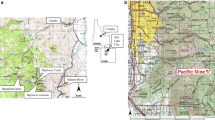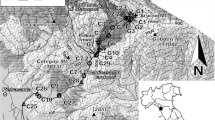Abstract
Changes in metal speciation occurring along the river Vormbäckenhave been investigated, and the potential for using such changes to reduce metal transport to areas further downstream has been evaluated.Vormbäcken is situated in a mining region in northern Sweden. Catchment area features likely to influence metal speciation include wetlands situated along the river, addition of treated (liming) effluent water from a mine area, and addition of other surface waters and groundwater. Surface water samples were collected from seven stations along the river on six occasions, representing different flow regimes. The total As, Ca, Cd, Cu, Fe, Pb, and Zn concentrations in the samples were partitioned into particulate (>0.4 μm and 0.2–0.4 μm, or only >0.2 μm) and dissolved (<0.2 μm, either associated with organiccarbon, or as free metal ions and inorganic complexes) fractions by means of filtration and an ion-exchange technique. The most important finding is that, with the exception of Ca, the fraction of particulate bound metals increased with increasing concentrations of particulate Fe. This Fe has its origin in surface waters and groundwater that join the river on its way through the catchment area. It is suggested that adsorption to, or co-precipitation with, such Fe-containing particles may have potential to be used as the initial step in a treatment method based on natural attenuation processes. Furthermore, the fraction of particulate bound metals decreased dramatically upon passing the lake Vormträsket, suggesting that some of these metals may be removed from the river system, at least temporally.
Similar content being viewed by others
References
Alpers, C. N. and Nordstrom, D. K.: 2000, 'Estimation of Pre-mining Conditions for Trace Metal Mobility in Mineralized Areas: An Overview', in Proceedings from the Fifth International Conference on Acid Rock Drainage, Denver, CO, 21–24 May 2000, The Society for Mining, Metallurgy, and Exploration, Inc., Littleton, CO, pp. 463–472.
Benjamin, M. M. and Honeyman, B. D.: 1992, 'Trace Metals', in S. S. Butcher, R. J. Charlson, G. H. Orians and G. V. Wolfe (eds), Global Biogeochemical Cycles, Academic Press, London, England, pp. 317–352.
Cowan, C. E., Zachara, J. M. and Resch, C. T.: 1991, 'Cadmium adsorption on iron oxides in the presence of alkaline-earth elements', Environ. Sci. Technol. 25, 437–446.
Daniel, W. W.: 1991, Biostatistics: A Foundation for Analysis in the Health Sciences, 5th ed., John Wiley & Sons, New York, NY, pp. 404 and 613–615.
Davison, W.: 1993, 'Iron and manganese in lakes', Earth-Sci. Rev. 34, 119–163.
Goulet, R. R., Leclair, E. N. and Pick, F. R.: 2001, 'The evaluation of metal retention by a constructed wetland using the pulmonate gastropod Helisoma trivolvis (Say)', Arch. Environ. Contam. Toxicol. 40, 303–310.
Green-Pedersen, H., Jensen, B. T. and Pind, N.: 1997, 'Nickel adsorption on MnO2, Fe(OH)3, montmorillonite, humic acid and calcite: A comparative study', Environ. Technol. 18, 807–815.
Hamilton-Taylor, J., Davison, W. and Morfett, K.: 1996, 'The biogeochemical cycling of Zn, Cu, Fe, Mn, and dissolved organic C in a seasonally anoxic lake', Limnol. Oceanogr. 41, 408–418.
Hamilton-Taylor, J., Giusti, L., Davison, W., Tych, W. and Hewitt, C. N.: 1997, 'Sorption of trace metals (Cu, Pb, Zn) by suspended lake particles in artificial (0.005 M NaNO3) and natural (Esthwaite Waters) freshwaters', Colloids Surf. A: Physicochem. Eng. Aspects 120, 205–219.
Hemond, H. F.: 1990, 'Wetlands as the Source of Dissolved Organic Carbon to SurfaceWaters', in E. M. Perdue and E. T. Gjessing (eds), Organic Acids in Aquatic Ecosystems, John Wiley & Sons, Chichester, pp. 301–313.
Hering, J. G. and Morel, F.M.M.: 1988, 'Humic acid complexation of calcium and copper', Environ. Sci. Technol. 22, 1234–1237.
Jenne, E. A.: 1968, 'Controls on Mn, Fe, Co, Ni, Cu, and Zn Concentrations in Soils and Water: The Significant Role of Hydrous Mn and Fe Oxides', in R. F. Gould (ed.), Trace Inorganics in Water, American Chemical Society, Washington, DC, pp. 337–387.
Karlsson, S., Peterson, A., Håkansson, K. and Ledin, A.: 1994, 'Fractionation of trace metals in surface water with screen filters', Sci. Total Environ. 149, 215–223.
L'her Roux, L., Le Roux, S. and Appriou, P.: 1998, 'Behaviour and speciation of metallic species Cu, Cd, Mn and Fe during estuarine mixing', Mar. Pollut. Bull. 36, 56–64.
McKnight, D. M., Bencala, K. E., Zellweger, G. W., Aiken, G. R., Feder, G. L. and Thorn, K. A.: 1992, 'Sorption of dissolved organic carbon by hydrous aluminum and iron oxides occurring at the confluence of Deer Creek with the Snake River, Summit County, Colorado', Environ. Sci. Technol. 26, 1388–1396.
Pandey, A. K., Pandey, S. D. and Misra, V.: 2000, 'Stability constants of metal-humic acid complexes and its role in environmental detoxification', Ecotoxicol. Environ. Saf. 47, 195–200.
Paulson, A. J. and Balistrieri, L.: 1999, 'Modeling removal of Cd, Cu, Pb, and Zn in acidic groundwater during neutralization by ambient surface waters and groundwaters', Environ. Sci. Technol. 33, 3850–3856.
Pettersson, C., Håkansson, K., Karlsson, S. and Allard, B.: 1993, 'Metal speciation in a humic surface water system polluted by acidic leachates from a mine deposit in Sweden', Water Res. 27, 863– 871.
Ranville, J. F., Smith, K. S., McKnight, D. M., Macalady, D. L. and Rees, T. F.: 1991, 'Effect of Organic Matter Coprecipitation and Sorption with Hydrous Iron Oxides on Electorphoretic Mobility of Particles in Acid Mine Drainage', in G. E. Mallard and D. A. Aronson (eds), U.S. Geological Survey Toxic Substances Hydrology Program – Proceedings of the Technical Meeting, Monterey, CA, 11–15 March 1991, Water-Resources Investigations Report 91-4034, U.S. Geological Survey, Reston, VA, pp. 422–427.
Runnells, D. D., Shepherd, T. A. and Angino, E. E.: 1992, 'Metals in water – Determining natural background concentrations in mineralized areas', Environ. Sci. Technol. 26, 2316–2323.
Sholkovitz, E. R.: 1976, 'Flocculation of dissolved organic and inorganic matter during the mixing of river water and seawater', Geochim. Cosmochim. Acta 40, 831–845.
Sholkovitz, E. R. and Copland, D.: 1981, 'The coagulation, solubility and adsorption properties of Fe,Mn, Cu, Ni, Cd, Co and humic acids in river water', Geochim. Cosmochim. Acta 45, 181–189.
Singh, S. K. and Subramanian, V.: 1984, 'Hydrous Fe and Mn oxides-scavengers of heavy metals in the aquatic environment', CRC Crit. Rev. Environ. Control 14, 33–90.
Sjöblom, Å., Håkansson, K. and Allard, B.: 2001, 'Metal Concentrations along a Mining Region Recipient – Some Aspects on Water Quality', in Proceedings from Securing the Future – International Conference on Mining and the Environment, Skellefteå, Sweden, 25 June–1 July 2001, pp. 777–786.
St. Louis, V. L., Rudd, J. W. M., Kelly, C. A., Beaty, K. G., Flett, R. J. and Roulet, N. T.: 1996, 'Production and loss of methylmercury and loss of total mercury from boreal forest catchments containing different types of wetlands', Environ. Sci. Technol. 30, 2719–2729.
Świderska-Bróż, M.: 1991, 'On the manifold role of lime coagulation', Water, Sci. Technol. 7, 247–253.
Tipping, E.: 1993, 'Modeling the competition between alkaline earth cations and trace metal species for binding by humic substances', Environ. Sci. Technol. 27, 520–529.
Vaughan, D. and Ord, B. G.: 1994, 'Influence of dissolved humic substances on the deposition of iron in field drains', Sci. Total Environ. 152, 73–80.
Webster, J. G., Swedlund, P. J. and Webster, K. S.: 1998, 'Trace metal adsorption onto an acid mine drainage iron(III) oxy hydroxy sulfate', Environ. Sci. Technol. 32, 1361–1368.
Author information
Authors and Affiliations
Corresponding author
Rights and permissions
About this article
Cite this article
Sjöblom, Å., Håkansson, K. & Allard, B. River Water Metal Speciation in a Mining Region – The Influence of Wetlands, Liming, Tributaries, and Groundwater. Water, Air, & Soil Pollution 152, 173–194 (2004). https://doi.org/10.1023/B:WATE.0000015355.50606.a5
Issue Date:
DOI: https://doi.org/10.1023/B:WATE.0000015355.50606.a5




